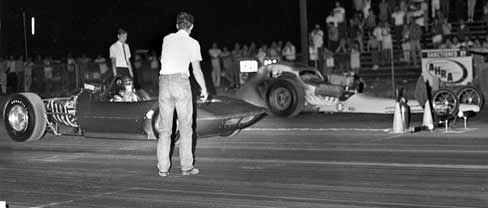| 
AMT’s Piranha:
The Missing Link
4/8/05
 henever
the subject of successful back-motored race cars comes up,
I’m invariably bothered by the omissions of some significant
creations of the '50s and ’60s. Granted, Don Garlits
and Connie Swingle built the one that went the fastest, made
the most money, had the greatest design influence, and undoubtedly
saved the most lives. So, Garlits wins; no contest! (No letters,
please.) henever
the subject of successful back-motored race cars comes up,
I’m invariably bothered by the omissions of some significant
creations of the '50s and ’60s. Granted, Don Garlits
and Connie Swingle built the one that went the fastest, made
the most money, had the greatest design influence, and undoubtedly
saved the most lives. So, Garlits wins; no contest! (No letters,
please.)
However, prior to the ’71 Swamp Rat, not every mid-engined
fuel car was impossible to drive and “bad luck.”
The one that possibly worked best of all gets no respect.
It was a car without a class.
Although the AMT Piranha was heavily promoted in national
magazine ads as “The World’s Fastest Funny Car!",
it really wasn’t, and everyone knew it. Nor did it fit
the criteria for dragsters of that era, which were longer,
mounted their motors up front, and didn’t have a weird
plastic body (supposedly molded from the same stuff as AMT’s
model kits) that looked like a bathtub — and was satirized
as such by cruel cartoonists and columnists. Top Fuel racers
called it a slow dragster. Funny Car racers refused to race
it. They all hated the Piranha, whatever it was.

In the mid-60s, you never knew what was
going to pull through the pit gate on any given weekend. When
the brand-new Piranha showed up at Beeline Dragway for shakedown
runs, promoter Rick Lynch suggested a three-round match race
with Frank Pedregon’s outrageous Competition Coupe.
(Photo by J.R. Hollenbeck)
Driver Walt Stevens and mechanic Joe Anahory didn’t
much give a crap what anybody was saying; they were too busy
pinching themselves! Imagine: two young guys getting handed
the keys to a complete race car, trailer and tow car in the
exhibition-crazed mid-Sixties — plus an expense account,
plus 400 bucks a week, each. All they had to do was get it
built by May and hit the road.
The unconventional chassis was designed and constructed in
Phoenix by Fred Smith, with fulltime assistance from Stevens,
at AMT Corporation’s Speed And Custom Equipment Division.
(Ironically, Smith had previously helped Garlits build Swamp
Rat slingshots.) Gene Winfield, the customizer, was in charge
of the Arizona operation, where AMT was producing full-sized,
gull-winged, Corvair-powered, rear-engined street cars. AMT
had acquired production rights from the Marbon Chemical division
of Borg-Warner, which built a prototype coupe to demonstrate
a super-strong plastic compound called Cycolac. Originally
dubbed “CRV” (for Cycolac Research Vehicle) by
Borg-Warner, the name was changed to Piranha when AMT jumped
into the production-car business.
Utilizing the then-new process of thermoforming, Winfield
molded the race car’s one-off body from two sheets of
Cycolac, which were glued together at the side seam. One reason
this wingless, scary-short creation handled so well was an
innovative air-intake system, installed behind the grille
opening. Air vented out through the “hood” reportedly
produced significant downforce, thereby preventing the Piranha
from getting airborne at 190-plus.
Anahory, one-third of Brooklyn’s infamous Dead-End
Kids dragster team, knew how to build big horsepower. This
time, he also needed maximum durability. His nitro-burning
Chrysler would be running multiple match races each week from
May through September, and almost nobody carried spares in
those days. Remarkably, Joe’s original 392 survived
the entire season! In a recent interview, Walt Stevens revealed
that Anahory “borrowed” the winning combination
from buddies Bob Skinner and Tom Jobe: “It was a ‘Surfers
motor’: 98 percent, lotta lead, lotta blower,”
said Stevens.

|
